Last updated: 11 October 2004
|
|
Last updated: 11 October 2004 |
Some LXD55 users have sent me examples of their astrophotography. If you have some examples you would like included here please send me a description of how you made the astrophotos and a copy of the images as GIF or JPEG files (due to internet email gateway issues, please send only one image file per message or ZIP or Stuff multiple files). Send to mweasner@optcorp.com. Alternatively, if you have created your own web page with your examples please let me know and I'll include a link to your site.
| Submitted by: Test.DWolf@DNS-GmbH.de (Test.DWolf@DNS-GmbH.de) [11 Oct 04] |
|---|
|
one of the less prominent galactic clusters (Messier missed it):
NGC 6934 in constellation 'Delphinus'. Not so big as the 'famous ones'. About 9m total brightness in a round disc of about 2' in diameter. The star close to the cluster in the west (right) is about 9m too, but looks brighter. Partially resolved, the brightest single stars in the cluster rate at about 16m. Dieter Wolf (Munich, Germany); 2004-10-05 22:30 CEST (20:30 UTC); MEADE LXD55 SN-10 with PHILIPS ToUCam SC1 at prime focus; 3 minutes total exposure time (18x10s) Thanks for your work Mike |
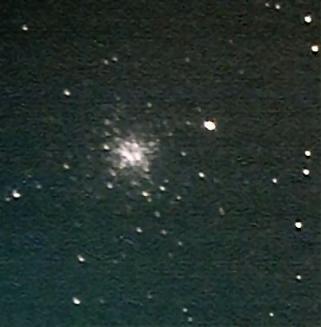
|
| Submitted by: Dieter.Wolf@DNSint.com (Dieter.Wolf@DNSint.com) [16 Sep 04] |
|
I did a new try on the 'big one' of northern GC's: M13 - what a bunch of
stars!
Dieter Wolf (Munich, Germany); 2004-09-05 22:40 CEST (20:40 UTC); MEADE LXD55 SN-10 with PHILIPS ToUCam SC1 at prime focus; abt. 14 min total exposure time (85 of 145 by 10 s) |
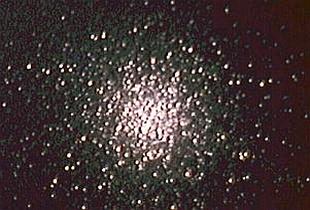
|
| Submitted by: Dieter.Wolf@DNSint.com (Dieter.Wolf@DNSint.com) [7 Sep 04] |
|
one of the less spectacular globular clusters:
M56 in Lyrae (total brightness about 8-9m, brightest stars about 13m) Dieter Wolf (Munich, Germany); 2004-09-05 22:50 CEST (20:50 UTC); MEADE LXD55 SN-10 with PHILIPS ToUCam SC1 at prime focus; 6 minutes total exposure time (60 of 100 by 10s) |
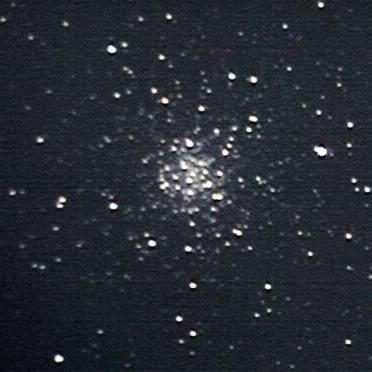
|
| Submitted by: Dieter.Wolf@DNSint.com (Dieter.Wolf@DNSint.com) [20 Aug 04] |
|
continuing with 'summer sky standards' this is M27 / NGC6853 in Vulpecula,
the first planetary nebula ever discovered. It is easily visible in a 10x50
binocular as a large blueish disc. Astonishing for me it was difficult to
find in the webcam preview as the surface brightness was not too high. It
is 6...8' in diameter; that's 1/4 of moon's size. Vertical to the bright
'dumbbell' axis you nicely see the weaker parts forming a somehow 'round'
view of the nubula. Lots of foreground stars and the 13m.5 blueish subdwarf
central star. Dieter Wolf (Munich, Germany); 2004-08-09 01:00 CEST; MEADE LXD55 SN-10 with PHILIPS ToUCam SC1 at prime focus; 14 out of 21 x 25s exposures Thanks for posting and always clear skies, |
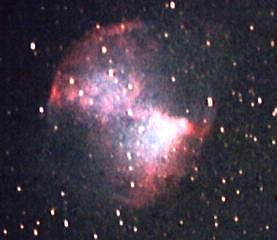
|
|
last night gave me a chance to redo M57 - I think it's better than my last
one.
Dieter Wolf (Munich, Germany); 2004-08-18 23:20 CEST (21:30 UTC); MEADE
LXD55 SN-10 with PHILIPS ToUCam SC1 at prime focus; 78 of 103 x 10s frames
stacked
I like the filigreed structures and 'pretty colors'.
Thanks for posting Mike, always clear skies, |
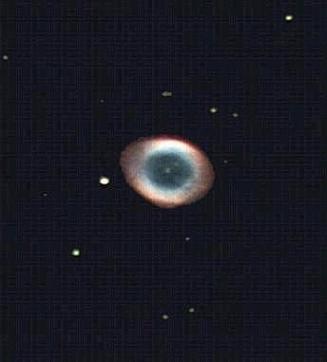
|
| Submitted by: Dieter.Wolf@DNSint.com (Dieter.Wolf@DNSint.com) [8 Aug 04] |
|
after nearly two months of astronomical inactivity here are my newest
photos of two 'standard summer objects to show'.
Dieter Wolf (Munich, Germany); MEADE LXD-55 SN-10 with PHILIPS ToUCam SC1 at prime focus Albireo (beta Cygni) - the easy resolvable bright double with nice 'reddish-blueish' color contrast; 2004-07-30 23:30 CEST (21:30 UTC); 40x1s |
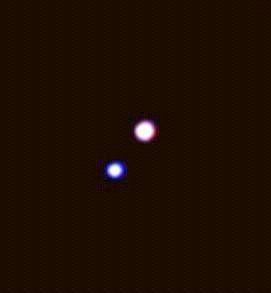
|
|
M57 - the Ring Nebular in Lyra; 2004-07-30 23:00 CEST (21:00
UTC); 80of109x10s The planet sized, 15m.3 white dwarf star can be clearly seen. Though a full moon night (but far off and low above the horizont) stars down to 16m.6 appear. The inner part of the 'ring' shows blue colors (never have seen green colors as some photographs show) in contrast to the more red parts of the ring itself. I tried a UHC filter which helped to reduce the bright sky when visually viewing but was a draw back in photography. |
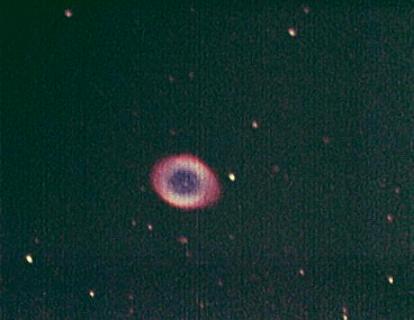
|
|
here last nights object - M92. Dieter Wolf (Munich, Germany); 2004-08-05 22:30 CEST (20:30 UTC); MEADE LXD55 SN-10 with PHILIPS ToUCam SC1 at prime focus; 2 minutes total exposure time M92 / NGC6341 a globular cluster in Hercules; M13's 'little brother' and because of that often disregarded; with 6m.4 just a bit weaker than M13 but 1/3 smaller in size and thus not so impressive Thanks for your work Mike and always clear skies, |
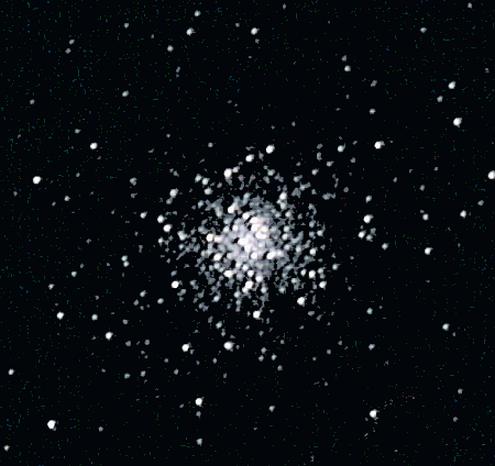
|
Go to the previous 2004 Guest Deepsky Astrophotography Page.
Go to the 2003 Guest Deepsky Astrophotography Page.
Go to back to my LXD55 Home Page.